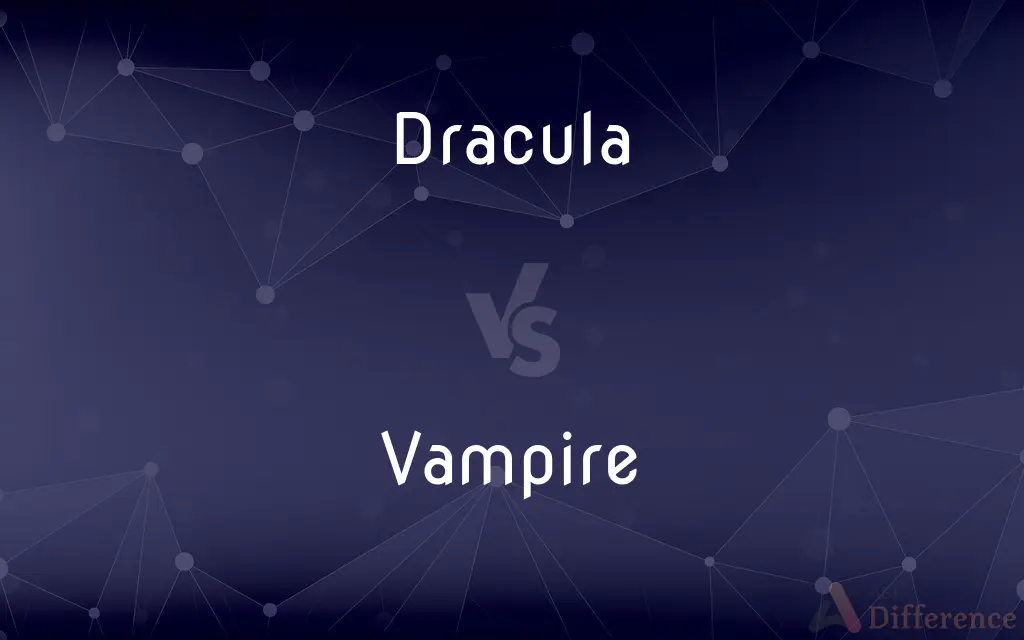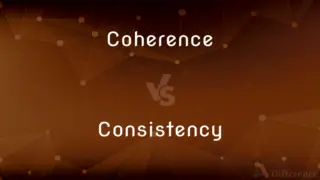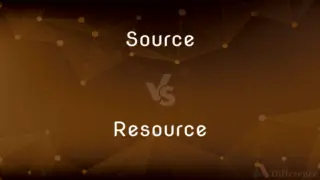Dracula vs. Vampire — What's the Difference?
By Tayyaba Rehman — Updated on September 23, 2023
Dracula is a fictional character from Bram Stoker's 1897 novel, representing a specific vampire with unique traits and a complex backstory. A vampire is a mythical creature that sucks the blood of the living.

Difference Between Dracula and Vampire
Table of Contents
ADVERTISEMENT
Key Differences
Dracula is a specific character originating from Bram Stoker's 1897 novel of the same name. This character has his own unique story, background, and specific set of abilities and weaknesses. In contrast, the term "vampire" is more general and refers to a mythical creature that sucks the blood of living beings to sustain itself. Vampires can have various characteristics depending on the cultural lore from which they come.
Both Dracula and vampires exist within the realm of horror and supernatural fiction, but Dracula is often considered the archetype of the modern Western vampire. While Dracula has specific motives, a particular place of origin (Transylvania), and certain vulnerabilities like an aversion to garlic and sunlight, vampires in general might not share these specific traits. Some vampires in different cultures and stories might be able to walk in daylight or have different limitations.
Dracula has become so iconic that he's often used as a synonym for vampires, but this usage can be misleading. The name "Dracula" refers to just one vampire, with a particular set of characteristics developed by Stoker. Vampires, on the other hand, are diverse creatures with various traits that have been developed across multiple cultures and folklore.
In terms of cultural impact, Dracula has spawned countless adaptations in movies, TV shows, and other media. Vampires, in a more general sense, have also inspired a wide range of stories, but these are not confined to any one character or set of rules. The vampire myth exists globally, from the Chinese "Jiangshi" to the Slavic "Nosferatu," showing the wide-ranging adaptability of the vampire concept.
Comparison Chart
Origin
Bram Stoker's 1897 novel
Various mythologies
ADVERTISEMENT
Specificity
One specific character
General term
Abilities
Defined set of abilities
Varies by folklore
Cultural Impact
Movies, TV adaptations
Global mythologies
Vulnerabilities
Garlic, sunlight, etc.
Varies by folklore
Compare with Definitions
Dracula
Dracula hails from Transylvania and is a Count.
In the novel, Dracula resides in a castle in Transylvania.
Vampire
A vampire is a mythical creature that sucks the blood of the living.
Vampires are popular subjects in horror fiction.
Dracula
Dracula is often considered the archetype of the modern Western vampire.
Many traits commonly associated with vampires were popularized by Dracula.
Vampire
Vampires can have different abilities and weaknesses based on cultural lore.
In some stories, vampires can transform into bats.
Dracula
Dracula is a fictional character created by Bram Stoker.
Dracula is one of the most famous characters in horror literature.
Vampire
Vampires are immortal and can live forever unless killed.
A vampire can live for centuries if not slain.
Dracula
Dracula has specific vulnerabilities like garlic and sunlight.
Dracula can be warded off with garlic and is weakened by sunlight.
Vampire
Vampires are undead beings.
Vampires are often depicted as risen from the grave.
Dracula
Dracula can transform into other creatures like bats and wolves.
Dracula's ability to transform allows him to elude capture.
Vampire
A vampire is a creature from folklore that subsists by feeding on the vital essence (generally in the form of blood) of the living. In European folklore, vampires are undead creatures that often visited loved ones and caused mischief or deaths in the neighbourhoods they inhabited while they were alive.
Dracula
Dracula is a novel by Bram Stoker, published in 1897. As an epistolary novel, the narrative is related through letters, diary entries, and newspaper articles.
Vampire
In popular folklore, an undead being in human form that survives by sucking the blood of living people, especially at night.
Dracula
Comprises tropical American species usually placed in genus Masdevallia: diminutive plants having bizarre and often sinister-looking flowers with pendulous scapes and motile lips
Vampire
A person, such as an extortionist, who takes advantage of others, especially for personal gain.
Dracula
Fictional vampire in a gothic horror novel by Bram Stoker
Vampire
A vampire bat.
Vampire
A mythological undead creature said to feed on the blood of the living.
Vampire
(colloquial) A person with the medical condition systemic lupus erythematosus, colloquially known as vampirism, with effects such as photosensitivity and brownish-red stained teeth.
Vampire
A blood-sucking bat; vampire bat (Desmodus rotundus)
Vampire
A person who drains one's time, energy, money, etc.
Vampire
(dated) A vamp: a seductive woman who exploits men.
Vampire
A medical technician who works with patients' blood.
Vampire
Synonym of anti-ship missile(ASM), particularly an incoming hostile one.
Vampire. Vampire. Vampire. Battle stations.
Vampire
To drain of energy or resources.
Vampire
A blood-sucking ghost; a soul of a dead person superstitiously believed to come from the grave and wander about by night sucking the blood of persons asleep, thus causing their death. This superstition was once prevalent in parts of Eastern Europe, and was especially current in Hungary about the year 1730. The vampire was often said to have the ability to transform itself into the form of a bat, as presented in the novel depicting the legend of Dracula published by Bram Stoker in 1897, which has inspired several movies.
The persons who turn vampires are generally wizards, witches, suicides, and persons who have come to a violent end, or have been cursed by their parents or by the church,
Vampire
Fig.: One who lives by preying on others; an extortioner; a bloodsucker.
Vampire
Either one of two or more species of South American blood-sucking bats belonging to the genera Desmodus and Diphylla; also called vampire bat. These bats are destitute of molar teeth, but have strong, sharp cutting incisors with which they make punctured wounds from which they suck the blood of horses, cattle, and other animals, as well as man, chiefly during sleep. They have a cæcal appendage to the stomach, in which the blood with which they gorge themselves is stored.
Vampire
Any one of several species of harmless tropical American bats of the genus Vampyrus, especially Vampyrus spectrum. These bats feed upon insects and fruit, but were formerly erroneously supposed to suck the blood of man and animals. Called also false vampire.
Vampire
(folklore) a corpse that rises at night to drink the blood of the living
Vampire
Vampires are often associated with fear of the dark and death.
Vampires are commonly used as metaphors for societal fears.
Common Curiosities
Is Dracula a vampire?
Yes, Dracula is a specific fictional vampire created by Bram Stoker.
Is Dracula the first vampire?
No, vampire myths existed long before Dracula, but he popularized many modern vampire traits.
Can vampires exist in daylight?
It depends on the specific lore; some vampires can, but Dracula, for example, is weakened by sunlight.
Where does Dracula come from?
Dracula is a character from Bram Stoker's 1897 novel and is from Transylvania.
What's the most famous Dracula adaptation?
Various adaptations exist, but the 1931 film starring Bela Lugosi is iconic.
Are all vampires like Dracula?
No, vampires can vary widely in abilities and characteristics depending on cultural lore.
What are vampires?
Vampires are mythical creatures that suck the blood of living beings to sustain themselves.
Can Dracula transform into other creatures?
Yes, in Stoker's novel, Dracula can transform into bats and wolves, among other creatures.
Is Dracula based on a real person?
Dracula is a fictional character, but he's often mistakenly associated with the historical Vlad the Impaler.
Do vampires have a reflection?
In most Western lore, including Dracula, vampires do not have a reflection.
What are Dracula's vulnerabilities?
Dracula is vulnerable to garlic, sunlight, and holy symbols.
Are vampires always evil?
In traditional lore, they are often malevolent, but modern interpretations can vary.
What makes Dracula unique?
Dracula has specific traits, motives, and vulnerabilities as described in Stoker's novel.
Are all vampires undead?
Generally, vampires are considered undead, though specifics can vary.
What do vampires represent?
Vampires often symbolize fears related to death, darkness, and the unknown.
Share Your Discovery

Previous Comparison
Coherence vs. Consistency
Next Comparison
Source vs. ResourceAuthor Spotlight
Written by
Tayyaba RehmanTayyaba Rehman is a distinguished writer, currently serving as a primary contributor to askdifference.com. As a researcher in semantics and etymology, Tayyaba's passion for the complexity of languages and their distinctions has found a perfect home on the platform. Tayyaba delves into the intricacies of language, distinguishing between commonly confused words and phrases, thereby providing clarity for readers worldwide.
















































